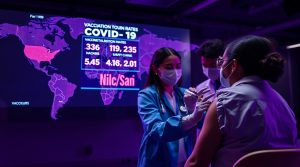
The COVID-19 pandemic has reshaped the world in unprecedented ways, highlighting the need for global cooperation, resilience, and innovation. A major development in the fight against the pandemic has been the rapid deployment of vaccines. Vaccination efforts have been instrumental in reducing the severity of COVID-19 cases, preventing hospitalizations, and saving lives worldwide. As of 2024, global vaccination efforts continue to evolve, with ongoing challenges and new strategies emerging to ensure equitable distribution and achieve herd immunity.
The Early Days of COVID-19 Vaccination
In December 2020, the first COVID-19 vaccines received emergency use authorization. The Pfizer-BioNTech and Moderna vaccines were among the first to be approved in many countries, offering high efficacy rates in preventing severe disease and transmission of the virus. The rollout of these vaccines marked a turning point in the battle against the pandemic, bringing hope to billions around the world.
The early days of the vaccine rollout were dominated by challenges, including the need for mass production, logistical hurdles in distribution, and initial hesitancy in some populations. Countries with advanced healthcare infrastructure were able to start vaccinating their populations quickly, but the situation in low- and middle-income countries was more complex due to limited access to vaccines.
Global Efforts to Ensure Vaccine Equity
To address disparities in vaccine access, global organizations like the World Health Organization (WHO), UNICEF, and Gavi, the Vaccine Alliance, launched initiatives like COVAX. COVAX aimed to ensure that vaccines were distributed equitably to countries, regardless of income level. The goal was to provide affordable vaccines to all nations, helping to mitigate the effects of the pandemic on poorer regions.
Despite the initial success of COVAX in distributing vaccines, challenges persisted. Wealthier nations secured large quantities of vaccines early on, leaving some low-income countries struggling to secure enough doses for their populations. However, through continued global cooperation and the scaling up of vaccine production, millions of doses were eventually delivered to countries in need.
Emerging Variants and Vaccine Adaptation
As vaccination campaigns advanced, the emergence of new COVID-19 variants posed additional challenges. Variants such as Delta and Omicron demonstrated increased transmissibility and, in some cases, reduced vaccine efficacy. In response, pharmaceutical companies began working on updated versions of their vaccines, including boosters, to provide protection against these variants.
Booster doses have become a critical part of the global vaccination strategy, particularly in countries with high vaccination rates. Research has shown that booster shots enhance immunity, especially in the face of evolving variants. Many countries have launched campaigns to vaccinate vulnerable populations with these boosters to maintain strong protection against severe illness.
The Role of Vaccination in Ending the Pandemic
Vaccination remains a critical tool in the fight against COVID-19, but it is not the only strategy. Public health measures such as mask-wearing, social distancing, and testing continue to play an essential role in controlling the spread of the virus. However, widespread vaccination is essential for reducing transmission, preventing hospitalizations, and ultimately achieving herd immunity.
Many experts believe that achieving global herd immunity will require vaccinating at least 70% of the world’s population. However, this is a challenging goal, as many regions still struggle with vaccine access, misinformation, and logistical difficulties. Increasing global vaccine production, improving infrastructure, and addressing vaccine hesitancy are essential steps toward achieving this goal.
Looking Ahead: The Future of COVID-19 Vaccination
As of 2024, significant progress has been made in global vaccination efforts, but the battle is not over. New variants of the virus continue to emerge, and global vaccination campaigns must adapt to ensure that all populations are protected. The future of COVID-19 vaccination will likely include ongoing booster shots, the development of new vaccine formulations, and the expansion of vaccination coverage to reach even the most remote areas of the world.
The global community must remain committed to equitable vaccine distribution, continued research, and cooperation to control COVID-19. By ensuring that vaccines reach every corner of the globe, we can continue to fight the pandemic and work toward a healthier, safer future for all.